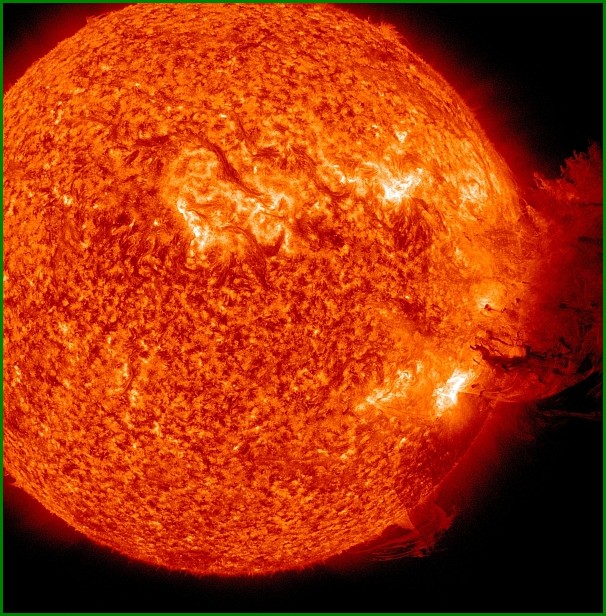The dependence of space weather from sunny climate Luke Barnard of the University of Reading (UK) and his colleagues have shown that the space-age history of mankind has coincided with a period of unusually high solar activity, nicknamed the great high.
Isotopes in ice sheets and tree rings suggest that such great solar maxima in the last 9,300 years was 24. The current is coming to an end, that is, indicators of the magnetic field of the sun will soon fall, will reduce the number of sunspots, coronal mass ejections will occur less frequently.

| Coronal mass ejection, the SOHO spacecraft photographed June 7, 2011. |
All of this will affect the cosmic radiation, which is very interested scientists and engineers, because it represents a threat to a variety of artificial systems (eg, satellites), as well as the potential to cause harm to astronauts and (to a lesser extent) the crew is particularly high flying aircraft.
The main sources of cosmic rays - galactic cosmic rays (continuous flow of high-energy particles reaching us from outside the solar system) and solar energetic particles that are accelerated thanks to the solar eruptions. The amount of radiation in the near-Earth space from these two sources is partly controlled by the magnetic field of the Sun.
There are theoretical predictions, supported by the observation that the decrease in the average magnetic field luminaries will lead to an increase in the number of galactic cosmic rays (GCR), reaching the vicinity of the Earth. Also predicted that, although the decline in solar activity will lead to less frequent emission of high energy particles, flash will be stronger and will cause more harm.
Meanwhile, the current space vehicles and aircraft are protected only by the level of radiation that was observed during the space age.
Comparing the current grand maximum of 24 previous, Mr. Barnard predicts an 8-percent probability that the solar activity will fall to very low levels, comparable to the so-called Maunder minimum XVII., During which it was observed a few sunspots. In this case, the GCR flux is likely to increase by 2.5 times compared to the present value, and large emissions of high-energy particles will occur about twice a century instead of the current five.
It is much more likely that in the next 40 years, solar activity will decline by about half, and in this case, the flow GCR increase 1.5 times, and large emissions of high-energy particles will occur eight times in a century. As a result, the near-Earth space radiation is likely to become more dangerous.
The results of the study were presented at the British-German national astronomical conference in Manchester.
in the wake of Computerra-Online and the Royal Astronomical Society.
Solar Earthquakes and Blackout Evidence
(CNN)-U.S. politics had its "Super Tuesday" yesterday, and so did the sun, says Joseph Kunches from NOAA's Space Weather Prediction Center in Boulder, Colorado.
That's because the sun had two solar flares associated with two coronal mass ejections. Coronal mass ejections involve massive amounts of energy and charged particles shooting out of the sun, and can cause problems if directed at Earth, as was the case over the last couple of days.
This event may stir up a geomagnetic storm, and lead to disruptions to high-frequency radio communications, global positioning systems and power grids, NASA's Goddard Space Flight Center said Wednesday. The peak of the storm is expected to hit Thursday morning; it may gradually diminish by Friday morning.
One of these coronal mass ejections is the strongest since December 2006, NOAA said. The equivalent of 10 billion tons of highly charged particles are hurtling at a rate of 3 million to 4 million miles an hour toward Earth. NASA says the leading edge of this coronal mass ejection will hit Earth at 1:25 a.m. E.T. (give or take seven hours).
The sun is currently in a cycle of increased sun spots. This is part of an 11-year cycle that is expected to peak over the next year. The magnetic field in a sunspot stores energy that is released in solar flares. These flares are intense bursts of radiation that get ejected into space.
NOAA measures various aspects of the ejections that occur. Four main components define solar activity: solar flares, coronal mass ejections, high-speed solar wind and solar energetic particles.
As an event occurs, some of the particles reach Earth almost immediately. These highly charged particles are more of a threat to spacecraft and astronauts than to us on the planet's surface. The bulk plasma from the coronal mass ejection can take between 30 and 72 hours to reach the earth. This can cause interruptions to power grids, GPS systems, and some flights that are near the poles.
The one positive outcome is the brilliant auroras (Northern and Southern Lights). These occur as the particles from the ejection interact with the Earth's magnetic field, creating colorful displays.
NOAA has a chart that classifies these solar storms. This latest coronal mass ejection is forecast to rate as a "strong G3" geomagnetic storm, a measure of the disturbances in the geomagnetic field that helps protect the Earth from dangerous particles, and a "severe S4" solar radiation storm which is a measure of radiation that occurs when the numbers of energetic particles increases.
The Space Prediction Center expects that we are in a favorable pattern for at least the next week to potentially bring more solar storms to the earth. What is not known is the magnitude of future events. What is expected is quite a show from the Northern Lights Wednesday night and Thursday night, which may be visible as far south as Michigan and Illinois.
http://lightyears.blogs.cnn.com/2012/...